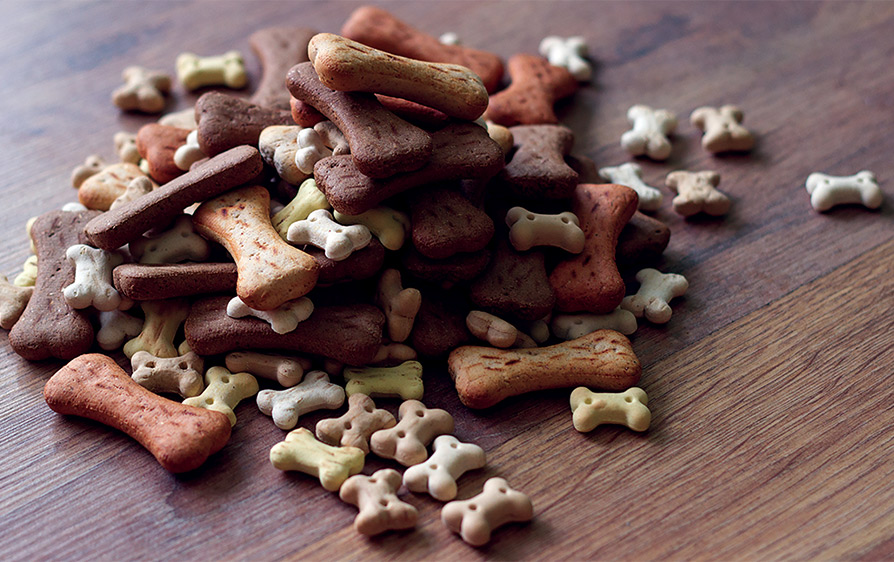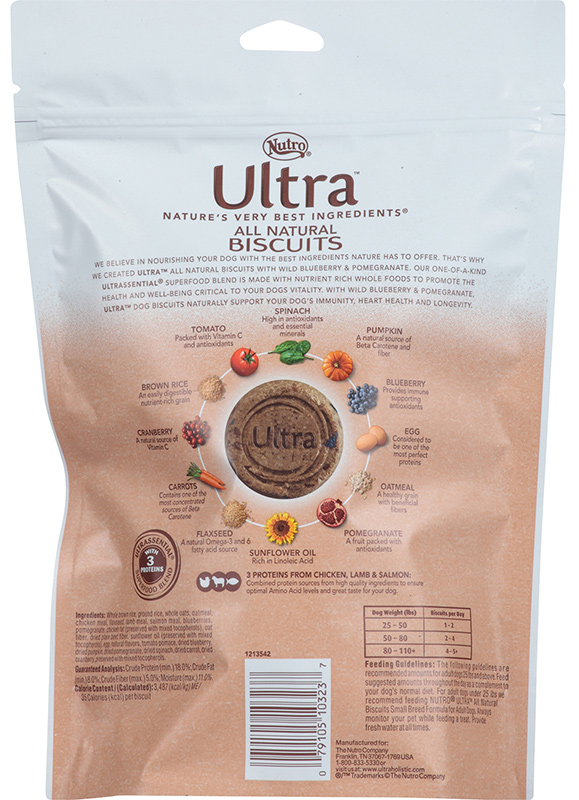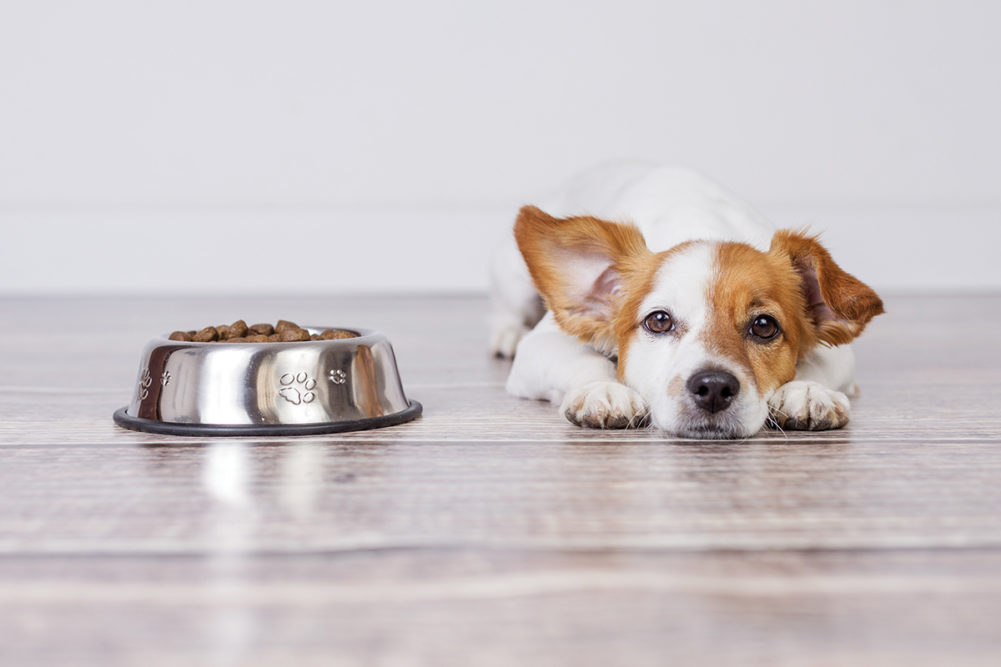This article was published in the June 2020 issue of Pet Food Processing. Read it and other articles from this issue in our June digital edition.
Antioxidants are powerful molecules that serve two purposes in pet foods. The first is to keep the food fresh, mainly by preventing the fats and oils from going rancid through a process known as lipid oxidation. The second is to keep the pet healthy by preventing free radicals in the body from damaging cells and having a deleterious effect on various biological functions.
These two purposes for antioxidant addition may create confusion for vigilant pet parent label readers. The required nomenclature for antioxidants may also raise eyebrows.
“The Association of American Feed Control Officials requires all animal food to use consistent, approved names for each ingredient,” said Eric Altom, technical nutritionist, animal health and nutrition, Balchem Corp., New Hampton, N.Y. “An ingredient that contains strategic antioxidant properties may look like a non-natural material because of the required name.”
There are many sources and forms of antioxidants. Isolated antioxidant ingredients, for example, may be extracted directly from foods, such as ascorbic acid (vitamin C) from citrus; however, it is possible to also replicate the structure of vitamins in the laboratory using chemicals, e.g., synthetic vitamins. Ingredient legends do not discriminate between the two.
Synthetic antioxidants, on the other hand, are just that. They are chemical combinations recognized as being cost-effective preservatives. Such ingredients often have complex chemical names, such as butylated hydroxyanisole and butylated hydroxytoluene.
Antioxidants may also be delivered through whole foods, namely fruits, vegetables and herbs. Extracts have also become quite common. These are concentrated forms neutralized for flavor and aroma.
Assisting with shelf life
Cats and dogs require fat in their diets and in greater amounts than humans. Fat not only provides energy, it is critical for proper cellular, hormonal and nerve function. It also contributes to the flavor and texture of the food, while keeping coats shiny.
Fats readily go rancid if not carefully protected. This is when they develop objectionable flavors and odors. There’s no way to prevent it completely, only to slow it, and there’s no recovery.
Fats degrade when fatty acids react with air, moisture or other compounds and break down into free fatty acids and other unstable compounds. Oxidative rancidity, also known as auto-oxidation, occurs in the presence of oxygen. Thus, the first step for delaying the inevitable is proper packaging and sealing.
Hydrolytic rancidity, also called hydrolysis or enzymatic oxidation, occurs in the presence of moisture and the absence of air. This normally is accomplished through enzymatic peroxidation, where enzymes found naturally in plant oils and animal fats catalyze reactions between water and oil.
A third type of fat degradation is microbial rancidity which occurs when enzymes from bacteria, mold or yeast break down the fat. Such excessive microbial growth usually visually renders the food inedible.
Higher temperatures, light, water, metal ions and biological catalysts may accelerate reactions. The presence and placement of unsaturated fatty acids on the fat molecule also influences the rate of degradation. Thus, fat selection comes into play when taking steps to delay degradation.
In general, the more polyunsaturated fatty acids on a fat molecule, the faster it will go rancid. This is due to the unstable double bonds that participate in the various degradation processes. Antioxidant systems containing different combinations of natural phenols, vitamins and organic acids may prevent or slow oxidation.
“Finding the antioxidant system that will preserve a pet food’s sensorial and nutritional properties throughout its shelf life is often a headache for pet food manufacturers,” said Robb Caseria, Videka LLC.
Fat degradation is an issue in all types of pet foods, with longer shelf life products such as dried kibble and jerky-style snacks being the most affected. But it is not just the inherent fat in meat, or the bulk oils added to recipes that may go rancid; specialty, better-for-pet ingredients containing polyunsaturated fatty acids are very unstable and highly prone to oxidation. This includes ingredients such as Omega-3 fatty acids, whole grains and nuts.
“Oxidation is a hot topic in the pet food industry,” said Robb Caseria, managing director, Videka LLC, Kalamazoo, Mich. “Finding the antioxidant system that will preserve a pet food’s sensorial and nutritional properties throughout its shelf life is often a headache for pet food manufacturers.”
Auto-oxidation – a chain reaction
Auto-oxidation occurs in three stages, with the first being the initiation. It is here where molecular oxygen combines with unsaturated fatty acids, producing hydroperoxides and peroxyl free radicals, both of which are highly reactive and unstable. The second stage is called propagation and occurs when these unstable byproducts of the first stage react with other lipids. This starts a chain reaction, with the reaction supplying its own accelerant.
At this point there is no turning back for the fat, as it is in a continuous cyclical oxidative degradation process that will only end upon the final stage, which is aptly known as termination. This can occur when the free radicals become highly concentrated and begin to react together, and by doing so, stop further reactions. Termination can also occur when reactions yield unreactive compounds, thus preventing further propagation. Reactions will also cease when an antioxidant enters the scenario. But at this point, any degradation that has already occurred is permanent. The fat cannot repair itself.
If objectionable flavors and odors have developed, they will remain. Initial rancid notes come from the secondary products produced during the initiation stage of auto-oxidation. When the peroxides eventually break down, they decompose into various aldehydes, ketones and acids that exert additional, and typically more putrid flavors and odors.
“An oxidized pet food will be perceived by pet owners as a sign of poor quality, or even a danger to their animal’s health,” Caseria said. “And actually, they are not completely wrong. The altered chemical structure of lipids makes them less bioavailable for the animals. So even though oxidation won’t harm a pet, it can certainly damage the food’s nutritional value.
“Limiting oxidation is crucial to preserve the shelf stability and nutritional quality of a pet food,” Caseria said.

The most common approach to inhibit lipid auto-oxidation is to include antioxidants in the formulation. This is often done throughout the supply chain, particularly with kibble manufacturing.
“Choosing the right place and the right moment for their addition is crucial,” Caseria said. “Antioxidants should be added as early as possible, as well as regularly throughout the manufacturing process.”
The fight against oxidation commonly starts at the renderer’s plant, where antioxidants are added in with the raw materials used to produce the fats, oils and meals that will go into the kibble.
“Additional antioxidants may also be added directly to the final meals and oils by the renderer prior to packaging,” Caseria said. “The fight then continues to the pet food manufacturer’s plant. When meals and oils are stored for a long period before being processed, or if they have not been stabilized at the renderer’s facility, pet food manufacturers may add antioxidants to protect them during extrusion.”
For extra protection with kibble and dried snacks, antioxidants may be sprayed on sealing each piece to ensure lipid preservation throughout the product’s shelf life.
Traditional synthetic antioxidants are very effective, easy to use and low cost. However, being chemically derived, they are undesirable in today’s clean label environment. In response, formulators are embracing clean label antioxidants, with the most common options classified as tocopherols (vitamin E) and high-phenolic plant extracts.
“Chemical antioxidants are liabilities in the clean label movement,” said Robert Ames, senior business development manager, Corbion, Lenexa, Kan., which markets natural antioxidants.
Kerry Courchaine, director of technical services, Darling Ingredients, Irving, Texas, said, “Where natural antioxidants were once only requested by premium and super-premium pet food brands, we now receive natural requests from mid-market pet food brands.”
Mixed tocopherols and botanical extracts are added to many of Darling Ingredients’ rendered products for pet food formulating.
“At times, a rendering plant may choose to use a natural chelator, such as citric acid or ascorbic acid, to bind free-radicals when rendering challenging raw materials with the potential for high ash content, which might otherwise promote oxidation during the rendering process,” Courchaine said. “Our facilities use a variety of natural antioxidant formulas, whether specified by a customer, or necessary due to some unique challenges of the rendered products.”
The technical team constantly monitors each pet food ingredient facility to determine the best natural option available to prevent oxidation. In recent years, a poultry industry trend has been to move toward all-vegetarian diets for their birds.
"The move away from rendered by-product meals toward more label-friendly rendered proteins, such as chicken meal and turkey meal, exacerbates the oxidation problem," said Robb Caseria, Videka LLC.
“These diets translate to higher levels of unsaturated and polyunsaturated fatty acids, which are more prone to oxidation,” Courchaine said. “The move away from rendered by-product meals toward more label-friendly rendered proteins, such as chicken meal and turkey meal, exacerbates the oxidation problem. These meat meals tend to be higher in ash, a source of oxidizing free radicals, such as copper and iron.
“Chicken meal and turkey meal are also the products of such raw materials as edible necks, backs, frames, skins, and bone residue from deboning operations,” she said. “These raw parts harbor strong oxidizing agents, such as chlorine and peracetic acid, used in carcass rinses.”
Altom added, “To ensure proper shelf life and long-term stability, it is critical to control the oxidative-reduction reactions. One way to support this foundation is to provide organic trace minerals. These are minerals bound to a ligand, a protein or amino acid, which reduces the antagonistic effects in a diet matrix and increases mineral bioavailability. By limiting the reactive capabilities of metals, you can help reduce substrates available for destructive reactions.”
In high-meat and fresh-meat pet foods, microencapsulated acidulants help with stability.
“These acidulants, such as lactic and citric acids, may be derived from natural fermentation processes,” Altom said. “Through the strategic use of microencapsulation, we are able to better control the pH of the total matrix. By reducing the pH of the matrix, we can create a hurdle for bacteria growth, prevent loss of moisture and natural flavonoids, and support more shelf-stable products.
“Many natural antioxidants can be pH sensitive for optimal performance,” Altom continued. “Therefore, leveraging an encapsulated acidulant may help enrich the environment and help maintain optimal performance of antioxidants.”
Kemin Industries, Des Moines, Iowa, has varied options to support pet food companies in assuring product freshness. In addition to producing time-tested synthetic antioxidants, the company has actively been involved in the antioxidant shift toward natural plant-based options. This includes mixed-tocopherols and plant-based extracts.
“Knowing where in the process to add antioxidants, how much to add and what antioxidant to use are critical to understanding how to stabilize pet foods,” said Jim Mann, Kemin Nutrisurance.
“Knowing where in the process to add antioxidants, how much to add and what antioxidant to use are critical to understanding how to stabilize pet foods,” said Jim Mann, senior global product manager with Kemin Nutrisurance’s Antioxidant and Food Safety Platform. “As pet food formulations change and use novel ingredients and more unsaturated fats, this can become more challenging and can require extensive testing and collaboration with antioxidant suppliers to identify the best antioxidant stabilization strategy.”
Antioxidant usage in shelf-stable wet foods is very different than with kibble. It gets even more complicated with refrigerated fresh products.
“Antioxidants can be added to the meat ingredients to help maintain their high quality and palatability,” Mann said. “In addition, antioxidants can potentially help with color retention and palatability of canned food.
“The oxidative stability of fresh and frozen food, or even freeze-dried food produced from fresh or frozen meats, is often overlooked,” he said. “Adding the appropriate antioxidant during emulsification or prior to freezing can help protect the quality of these products. Antioxidants can extend their shelf-life and maintain palatability if added early in their manufacturing process.”
For quality of life, too
In addition to ensuring product quality, antioxidants help maintain quality of life. The antioxidants for this purpose are generally those found in fruits and vegetables. Common antioxidants include vitamin A, vitamin C, vitamin E, and certain compounds called carotenoids, such as lutein and beta-carotene. They may be delivered in pet food through the addition of fruit and vegetable ingredients, including powders, concentrates and purées. The antioxidants may also be added in the form of isolated ingredients.
“Research shows each antioxidant benefits the immune system uniquely, so one antioxidant at high levels is not as effective as a group of antioxidants acting together,” Altom said.
“Research shows each antioxidant benefits the immune system uniquely, so one antioxidant at high levels is not as effective as a group of antioxidants acting together,” said Eric Altom, Balchem Corporation.
Jeannie Swedberg, director of business development, Tree Top Inc., Selah Wash., said, “Powerful antioxidants contained in these ingredients can help the body — human or animal — fight free radicals. Free radicals are highly reactive, oxygen-containing molecules that can damage cell membranes and enzymes, which makes the nervous and immune system especially vulnerable. Free radicals are considered factors in disease progression and premature aging.”
Free radicals result from oxidation, a natural process that occurs during digestion, exercise or simply breathing. They are produced in greater than normal amounts when pets are sick, elderly, exposed to pollution or suffer from poor nutrition. The more free radicals in the body, the greater the potential for irrevocable damage. That’s because once free radicals form, they can start a chain reaction, damaging healthy cells, which in turn can contribute to various afflictions. Antioxidants terminate these chain reactions by being oxidized themselves, thus preventing free radical damage.
The right amount or combination of antioxidants in pet food may assist with easing the pains and signs of aging. They help build immunity and temper allergies while also supporting overall health and wellness in pets.

“Recent research also examined the effect of aging on immune responses,” Altom said. “The findings indicate that as dogs and cats age, immune cell responses may decline. Including antioxidants in the diet can reverse the age-related decrease in immune cell function.”
Fruits and vegetables not only help meet a pet’s dietary needs, they also supply great tag appeal. “Front-of-packaging panel promotion or call-outs about the benefits these ingredients provide will attract the attention of caring pet parents,” Swedberg said.
As premium pet foods and treats continue to be popular and contain an increasing variety of proteins, fats and healthy ingredients, protecting those formulations will remain a challenge for processors, requiring close attention to antioxidants.
Read more about product development, ingredients and formulation.





